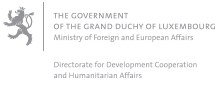- Home
- Preface
- Development Effectiveness
- World Humanitarian Summit
- I. Luxembourg’s official development assistance in 2016
- II. Cooperation with the main partner countries
- III. Regional cooperation and cooperation with other countries
- IV. Multilateral cooperation
- V. European Union
- VI. Cooperation with non-governmental development organisations
- VII. Humanitarian action
- VIII. Programme support
- IX. Development education and awareness raising
- X. Inclusive finance and the private sector
- XI. Evaluation
- XII. Report on the progress of the work of the Interministerial Committee for Development Cooperation in 2016
- Appendices
II. Cooperation with the main partner countries
Senegal

Vocational training programme in Kanel © Coumba Sow

Vocational training programme in Nioro © M.F. Boissy
Senegal
Population 15,13 million
Surface area 196723 km2
GNP per inhabitant (PPP in $) 2 288
Classification in HDI 162/188
2016 has been a major turning point for Luxembourg’s development cooperation in Senegal: the bilateral part of Luxembourg’s development programme has seen a growth in the use of the modality of national implementation known as “budgeted aid”, which should in time enable Senegalese actors to implement their development strategies and programmes fully. Due to its innovative nature, this modality was featured among ten best practice case studies at the high-level meeting of the Global Partnership for effective development cooperation that took place in Nairobi in November 2016.
The 12th partnership committee meeting took place on 15 November and was chaired by Minister Schneider and the Minister for Vocational Training, Learning and Craftsmanship (MFPAA), Mr Talla. The objective of the session was to review the main recommendations of the mid-term review of the third Indicative Cooperation Programme that took place in 2016 and to draw the broad outlines of the next ICP. The ICP III has also been extended by one year to the end of 2017 in order to align itself with the Priority Action Plan of the Plan for an Emerging Senegal as well as the joint programming cycle of the European Union in Senegal.
The research and technical assistance fund, established as part of ICP III, was activated in 2016 in order to establish a partnership between the Luxembourg company LuxTrust and the Senegalese government’s IT agency. Luxembourg’s development cooperation will thus assist Senegal in introducing electronic signatures, which will make administrative procedures safer and more effective.
The embassy in Dakar has also provided financial support to the “Bitter Oranges” project – “the bitter taste of Europe’s sweet oranges” – which aims to raising awareness among young potential emigrants of the inherent risks for and conditions of illegal migration to Europe. The project features an information caravan and the “Bitter Oranges” photographic exhibition.
2016 was also marked by the diversification of our relations, which are traditionally based on development assistance, through the greater involvement of the Luxembourg private sector, as demonstrated by the success of the first Luxembourg economic mission held in Dakar in February 2016.
Senegal

